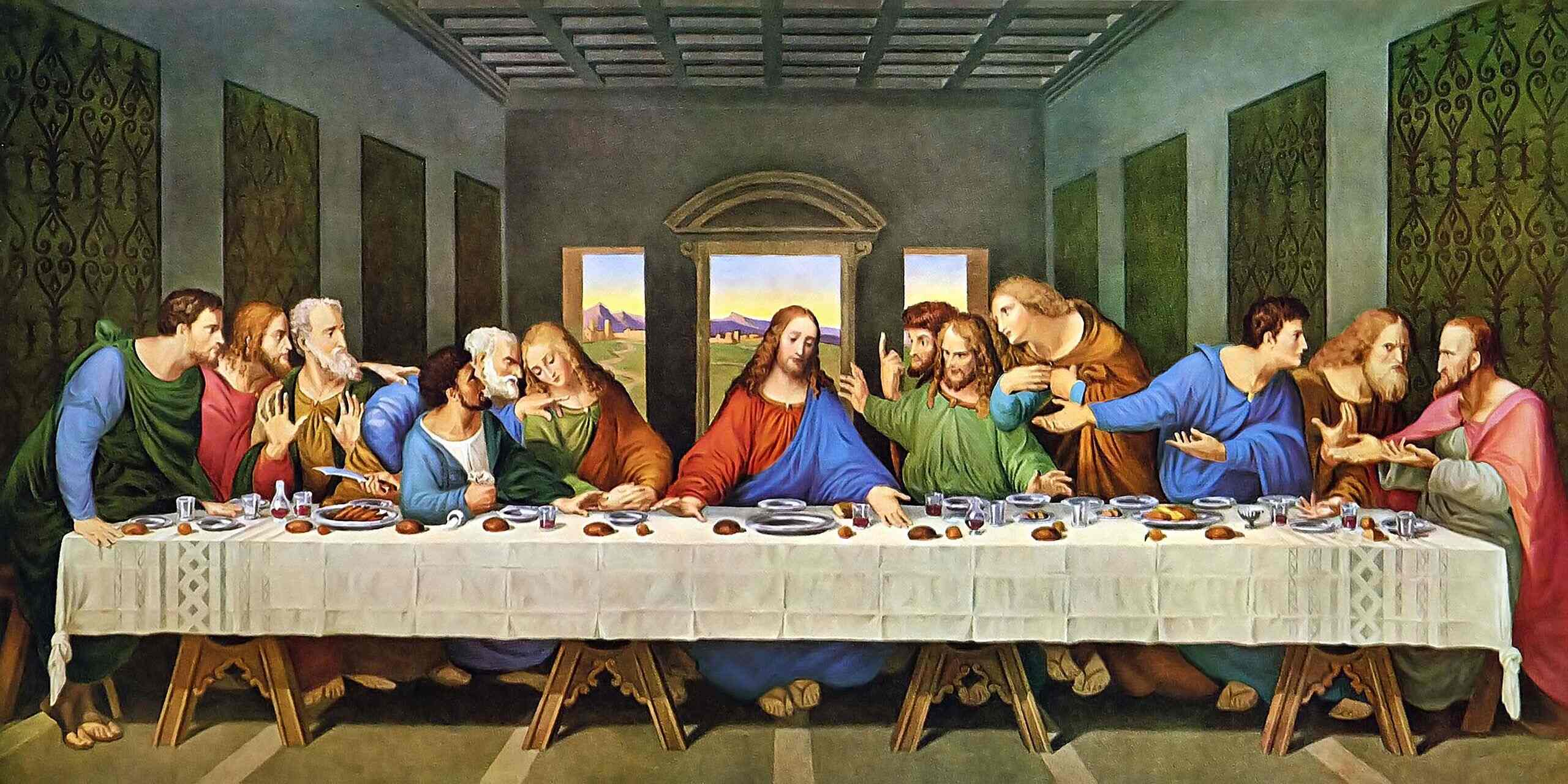
The Last Supper painting is a timeless masterpiece that has captivated art enthusiasts and religious scholars for centuries. Created by the legendary artist Leonardo da Vinci, this iconic work depicts the poignant moment when Jesus reveals that one of his disciples will betray him. The painting's intricate details and profound symbolism have sparked numerous interpretations and discussions, making it a subject of fascination and intrigue.
In this article, we will delve into 18 fascinating facts about The Last Supper painting, shedding light on its historical significance, artistic techniques, and enduring legacy. From the hidden details within the composition to the challenges faced by da Vinci during its creation, each fact unveils a new layer of insight into this renowned artwork. Whether you're an art aficionado, a history buff, or simply curious about this renowned painting, join us on a captivating journey through the enigmatic world of The Last Supper.
Key Takeaways:
- Leonardo da Vinci’s Last Supper painting captures the emotional moment of Jesus sharing his final meal with his disciples, inspiring countless interpretations and adaptations across various forms of media.
- Despite facing preservation challenges and sparking conspiracy theories, The Last Supper remains an enduring symbol of artistic brilliance and spiritual contemplation, captivating audiences worldwide for centuries.
The Last Supper painting was created by Leonardo da Vinci.
Leonardo da Vinci, the renowned Italian artist, completed The Last Supper painting between 1495 and This masterpiece, measuring 460 cm × 880 cm (180 in × 350 in), covers an entire wall at the refectory of the Convent of Santa Maria delle Grazie in Milan, Italy.
The Last Supper depicts the final meal Jesus shared with his disciples.
The painting captures the poignant moment when Jesus reveals that one of his apostles will betray him. The emotional reactions of the disciples are skillfully portrayed, adding depth and drama to the scene.
The Last Supper showcases da Vinci's innovative painting technique.
Da Vinci employed a unique method called tempera on gesso, grafted onto a stone wall. This technique, unfortunately, caused the painting to deteriorate over time, leading to numerous restoration attempts.
The Last Supper has faced significant preservation challenges.
Due to the painting's fragile state, restoration efforts have been ongoing for centuries. Environmental factors, such as humidity and war damage, have posed continuous threats to the artwork's preservation.
The Last Supper has inspired countless interpretations and adaptations.
This iconic painting has been referenced in various forms of media, including literature, music, and film. Its enduring influence is a testament to its profound impact on global culture.
The Last Supper has been the subject of numerous conspiracy theories.
The enigmatic nature of The Last Supper has sparked speculation and intrigue, with theories ranging from hidden codes within the painting to secret messages about the Holy Grail.
The Last Supper has been a source of fascination for art enthusiasts and scholars alike.
Art historians and enthusiasts continue to study and analyze The Last Supper, delving into its symbolism, composition, and historical significance.
The Last Supper's composition is a marvel of perspective and symmetry.
Da Vinci's meticulous attention to detail is evident in the painting's composition, with the vanishing point strategically placed at the figure of Jesus, drawing the viewer's gaze to the focal point of the scene.
The Last Supper has undergone extensive restoration efforts.
In 1980, a major restoration project was initiated to address the painting's deteriorating condition. The meticulous process aimed to stabilize the artwork and preserve its integrity for future generations.
The Last Supper has been a UNESCO World Heritage Site since 1980.
Recognizing its cultural and historical significance, The Last Supper was inscribed as a UNESCO World Heritage Site, ensuring its protection and conservation for years to come.
The Last Supper has captivated audiences for centuries.
Despite the passage of time, The Last Supper continues to captivate audiences worldwide, drawing visitors to the Convent of Santa Maria delle Grazie to witness its timeless allure.
The Last Supper has been the focus of in-depth scholarly research.
Scholars and researchers have dedicated extensive efforts to unraveling the mysteries surrounding The Last Supper, shedding light on its artistic innovations and theological symbolism.
The Last Supper has been a symbol of spiritual and artistic significance.
Beyond its religious connotations, The Last Supper stands as a testament to da Vinci's artistic genius and his ability to convey profound narratives through his work.
The Last Supper has left an indelible mark on art history.
As one of the most iconic and revered paintings in the world, The Last Supper has secured its place in art history, serving as a timeless symbol of creativity and spiritual contemplation.
The Last Supper has been the subject of popular culture references.
From parodies to homages, The Last Supper has permeated popular culture, appearing in various forms of media and serving as a source of inspiration for artists across different disciplines.
The Last Supper has sparked ongoing discussions and debates.
Its enigmatic nature continues to fuel discussions and debates among art enthusiasts, scholars, and theologians, adding to the enduring allure of this historic masterpiece.
The Last Supper has been a source of inspiration for artists across the centuries.
Countless artists have drawn inspiration from The Last Supper, incorporating elements of its composition and symbolism into their own works, further perpetuating its enduring legacy.
The Last Supper has stood the test of time as a timeless masterpiece.
Despite the passage of centuries, The Last Supper remains an enduring symbol of artistic brilliance and spiritual contemplation, continuing to resonate with audiences around the world.
The Last Supper painting by Leonardo da Vinci stands as a testament to the artist's unparalleled skill and creativity. Depicting the poignant moment of Jesus sharing his final meal with his disciples, the painting captures the emotional reactions of the apostles as they grapple with the revelation of betrayal. Da Vinci's innovative painting technique and meticulous attention to detail are evident in the composition, which has inspired countless interpretations and adaptations across various forms of media. Despite facing preservation challenges and sparking numerous conspiracy theories, The Last Supper continues to captivate audiences, serving as a symbol of spiritual and artistic significance. Its enduring legacy and cultural impact solidify its place as one of the most revered and iconic paintings in art history.
Conclusion
The Last Supper painting is a timeless masterpiece that continues to captivate and intrigue people around the world. Its historical significance, artistic brilliance, and enduring mysteries make it a subject of fascination for art enthusiasts, historians, and the general public alike. The painting's portrayal of the final meal shared by Jesus and his disciples has sparked numerous interpretations and debates, adding to its enigmatic allure. As we delve deeper into the intricacies of this iconic artwork, we uncover not only its artistic merit but also its profound cultural and religious significance.
FAQs
What is the Last Supper painting?
The Last Supper is a renowned mural painting created by Leonardo da Vinci in the late 15th century. It depicts the dramatic moment when Jesus reveals that one of his disciples will betray him, capturing the emotional reactions of the apostles.
Why is the Last Supper painting so famous?
The Last Supper painting is celebrated for its artistic innovation, historical significance, and the enduring intrigue surrounding its symbolism and hidden details. Leonardo da Vinci's masterful portrayal of the biblical scene has solidified its place as one of the most iconic and enigmatic works of art in history.
Was this page helpful?
Our commitment to delivering trustworthy and engaging content is at the heart of what we do. Each fact on our site is contributed by real users like you, bringing a wealth of diverse insights and information. To ensure the highest standards of accuracy and reliability, our dedicated editors meticulously review each submission. This process guarantees that the facts we share are not only fascinating but also credible. Trust in our commitment to quality and authenticity as you explore and learn with us.


